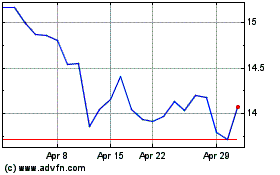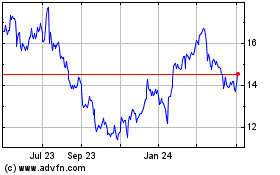Cartier's Wake-Up Call for Luxury Dreamers -- Heard on the Street
July 16 2020 - 9:18AM
Dow Jones News
By Carol Ryan
European luxury brands may be later than investors think to
benefit from China's rapid economic recovery.
Shares in Compagnie Financière Richemont, owner of the Cartier
and Van Cleef & Arpels jewelry brands, fell 5% in early
European trading Thursday after the Swiss company reported weak
sales for the three months through June. Sales at constant
currencies fell 47% compared with the same quarter of 2019.
Amid a pandemic that has richly rewarded some online players,
the big miss was at Richemont's e-commerce websites Net-a-Porter
and Watchfinder. Sales there fell 42% -- nearly double the drop
that analysts expected -- due to the temporary closure of
distribution centers. Service levels aren't back to normal in many
markets and aggressive price cuts are now needed to entice buyers
to spend online.
On Wednesday, British trench coat maker Burberry gave bearish
guidance about current trading. Its shares are down 8% so far this
week. Both companies sell a slightly larger chunk of their goods to
Chinese customers than the 35% industry norm.
The Chinese economy grew 3.2% in the second quarter compared
with the same period of 2019, according to official data released
Thursday. Investors have been hoping that the country's V-shaped
rebound, combined with its insatiable appetite for European luxury
goods, will offer brands some protection during the crisis.
Sales within China did increase by 49% for Richemont and a
"midteens" percentage at Burberry. But the numbers are deceptive:
Chinese shoppers typically buy overseas, where luxury goods are
cheaper than at home. Without the boost from travel, their spending
globally was down 35% in June compared with the same month last
year, according to UBS estimates.
Luxury consumption is likely to be depressed for several years
in other big luxury markets such as the U.S. and Europe, leaving
brands more dependent than ever on well-heeled Chinese shoppers.
Much of the industry's future demand is expected to come from
China's growing upper-middle class, currently around 65 million
individuals, who earn between $30,000 and $45,000 a year, based on
estimates by Morningstar analyst Jelena Sokolova. The question is
whether that group of consumers will continue to spend such a big
chunk of their disposable income on designer goods -- products
they, by definition, don't need -- in a grimmer economic
environment.
European luxury stocks head into this earnings season trading at
an 80% premium to the MSCI Europe index as a multiple of projected
earnings, according to UBS -- well above the sector's 47% long-term
average. Investors are beginning to wake up to the risks of pricing
brands for perfection when the outlook has never been less
certain.
Write to Carol Ryan at carol.ryan@wsj.com
(END) Dow Jones Newswires
July 16, 2020 09:03 ET (13:03 GMT)
Copyright (c) 2020 Dow Jones & Company, Inc.
Compagnie Financiere Ric... (PK) (USOTC:CFRUY)
Historical Stock Chart
From Mar 2024 to Apr 2024

Compagnie Financiere Ric... (PK) (USOTC:CFRUY)
Historical Stock Chart
From Apr 2023 to Apr 2024
